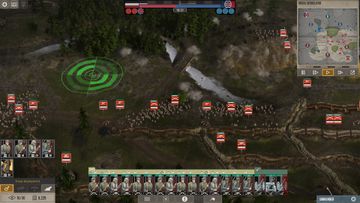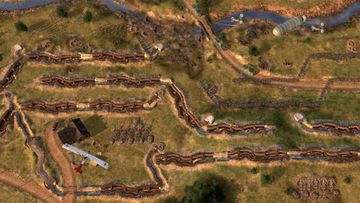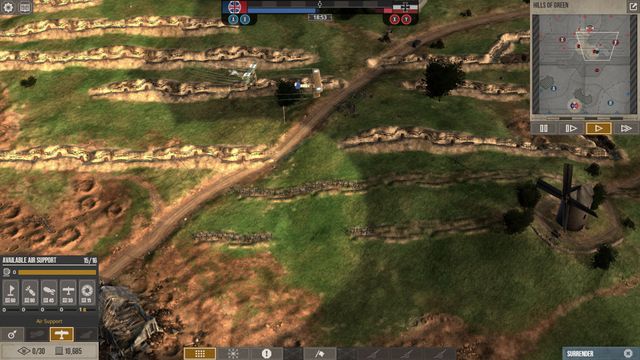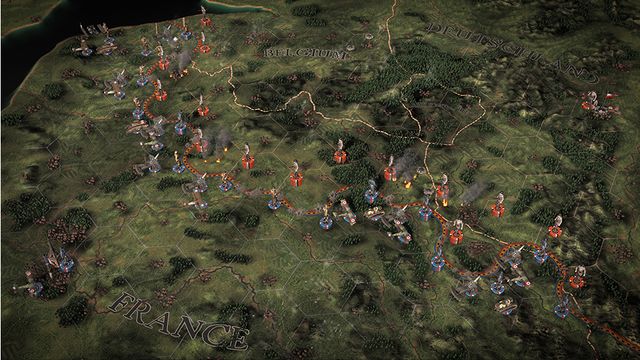


Dual-Role Commander: Strategise on All Levels in The Great War: Western Front
The First World War produced a significant change in the tactical elements of warfare, from establishing new technologies to gain an advantage, to adapting the strategies behind the deployment of resources. The Great War: Western Front from Petroglyph and Frontier Foundry is dedicated to replicating these changes and their importance to WW1 – and puts you in control of it all.
In the Campaign, you will experience immersive dual-role gameplay that gives you command of either the Allied Forces or Central Powers, both on the battlefield and on a much broader scale. Combining grand strategy and real-time strategy, your faction will be relying totally on you to guide them to victory, as both the Theatre Commander and Field Commander. Let’s look more closely at these two roles.
Theatre Commander
The role of Theatre Commander in The Great War: Western Front allows you to take the reins of your chosen side’s war effort at a grand strategy level, affecting not just the approach for battles and offensives, but the wider tactics of war.

The Campaign map is your main hub to operate all aspects under your control. A grid represents the Western Front, with each hexagon representing a territory that you are fighting for control over. Winning battles, and taking those territories, is vital. Each move you make as Theatre Commander counts as a turn, which represents one month. You are free to move your units to any controlled region across the Western Front during a turn - though you will be unable to move units and order them to attack or defend in the same turn. To support your soldiers in prominent locations, you can invest in structures, such as hospitals, to improve morale and reduce the cost of replenishing infantries. Consider how stacking heavy amounts of resources into one territory, to increase your chances of victory there, may well leave you vulnerable to an enemy onslaught elsewhere. Deploy your units across the region, try to anticipate the moves your enemy will make in their turn, and aim to strategically push the front line in your favour.
Resources and Currency
Achieving this will require careful tactical use of resources. In The Great War: Western Front, you will manage three main resources types throughout the Campaign:
Gold Reserves are the primary currency, which represents the economic power your faction holds. As Theatre Commander, use Gold Reserves to invest in key resources and heavy equipment as you push across the Western Front, such as maintenance costs, replenishing troops after a battle, and more. The amount of Gold Reserves available to you will be affected by your spending, but also by other factors. Gold Reserves will be generated after each turn, and certain key decisions you face during the Campaign can provide a boost or a hit to this currency. Keeping an eye on your level of Gold Reserves will be important; if you run out, and go into negative Gold Reserves due to mandatory replenishment of troops, you will be unable to initiate battles or purchase anything, until your debt is repaid.
Supply is your resource that represents all of your necessities when it comes to fighting a war, split into two sources: Corps Supply and World Supply. Corps Supply represents the basic supplies carried by soldiers; this can be increased through research and is replenished after each battle. World Supply, meanwhile, can only be generated by converting resources, or from specific events you'll encounter. There will be a limit, per turn, to how much you can convert - though the conversion rate of Gold Reserves to Supply can be improved via conducting specific research. The maximum supply you can draw into a region from the Global Bank of World Supply to supplement your Corps Supply for a battle can differ across regions. Building Supply Depots at a region will help increase that limit. Unlike Gold Reserves, you will be unable to go into a negative figure; if you run out of Supply, you will be unable to use it during battle. Later in this article, we will explain how you can use Supply on the battlefield as a Field Commander.
Research Points are the currency required to purchase upgrades and new technologies, as you conduct research into them. Research Points are earned per turn, or potentially received during significant moments of the Campaign, and can be stacked or used whenever you wish. Let's look at how you can spend those points...
Research and New Technologies

The arms race and necessity for both the Allied Forces and Central Powers to improve the tools for battle at their disposal is represented in The Great War: Western Front's research system. Here, Theatre Commanders can use Research Points to immediately unlock structures, boost the effectiveness of existing resources, and provide new options for both attack and defence. The more Research Points spent, and the more options you unlock, the greater your potential power in battle becomes.
Research is split into six areas: Flight, Infantry, Logistics, Engineering, Intelligence, and Trench. Choose whether to focus your research on any of these areas, or spread your focus across them. Think about the current strengths of your units and resources, and decide if your research should look to emphasise those strengths, or account for weaknesses. Do you want to support your troops better with your resources on the ground? Focus your research on Trench Warfare to improve aspects such as trench cover or machine gun spurs. Think you need something bigger to fight the enemy? Engineering research will unlock upgrades to existing artillery units, or even new tanks. Researching into other areas can help with wider factors of the conflict, like espionage.
The options and progression of the research system is a reflection of WW1, often replicating the advances and changes shown by both sides during the war. Many options in your research will be broken down into multiple levels, requiring you to purchase and unlock the first level, before being able to unlock the second and more effective level, and so on. The highest levels, and the most sought-after technologies, will cost you the most time and Research Points - but could be the defining breakthrough. Will you replicate the advances made in WW1, or take the progress of your faction in a different direction?
National Will
Success in The Great War: Western Front is not just calculated by territorial gains, but by the public support each side wields: their National Will. Maintaining your side’s National Will, whilst depleting the enemy’s, can be your key to overall victory – and as Theatre Commander, you will make decisions that directly the influence the backing you have from your people.
National Will can be affected by the outcome of any battle. Losing territory, or heavy troop casualties, can negatively impact National Will. Even victorious battles that come at a significant cost of soldiers and units will not go down well with the public, so carefully consider the human cost of each engagement.
Other aspects that can affect this are objectives, which offer varying rewards for completing, including National Will. Building specific resources, or researching a certain area within a set period of time, will bring its benefits, potentially including more support from your people. Additionally, throughout the Campaign you will be presented with important decisions which, as Theatre Commander, are yours to resolve. You will be given multiple options to solve the dilemma, with differing consequences including infantry availability, Gold Reserves, and National Will effects. Managing all of these areas closely, and making the right calls to limit the drop in National Will, is a crucial part of the role of Theatre Commander.
Prepare for Battle
All battles in The Great War: Western Front’s Campaign can be conducted at a Theatre Commander level. Factoring in all of the options and aspects we have mentioned, move your selected units and resources into territory you plan to battle for.
Whilst firepower and fortifications are imperative in any battle, so is intelligence. When you view an enemy-occupied region, there will be limitations in what you can see in terms of the enemy’s location, arrangements, and units deployed. Your use of espionage options at the Theatre Commander level will also dictate how much you knowledge you have on enemy units being deployed in any given territory. In WW1, both sides used observation balloons to attempt to get a bird’s eye view of their surroundings and understand what they are up against – and you can do the same in The Great War: Western Front, which we'll explain in more detail later on.

In the Battlefield Deployment area, you have the option to auto-resolve, which will simulate the battle, using the units you have selected for that territory. You will be presented with a ‘likely outcome’ window, showing the expected conclusion based on the parameters in place. Potential outcomes include victory for either side of varying degrees, or a stalemate, with marginal gains made one way or the other. Choosing to auto-resolve a battle could well come at the cost of more soldiers and resources than if you were to control the action yourself, as Field Commander...
Field Commander
In The Great War: Western Front, heading to the battlefield means taking the role of Field Commander. This puts in you in complete control of your side’s actions in battle, setting up troops and resources, and dictating the tactics of every moment of the conflict.
Laying the Groundwork

This begins before the battle commences, as your forces arrive at the scene to get ready for action. A pre-battle phase allows you to prepare for what lies ahead – and a large part of this focus may well be on creating a network of trenches. A variety of trench types (available dependent on the research you have undertaken) give your troops protected areas for movement, firing, and cover. Build defences into and around your trenches, too, such as machine gun nests, artillery, and barbed wire. Tanks and artillery can also be pre-placed to support your troops on any planned offensive. Set up your observation balloon, ready to deploy once confrontations begin. Select their placement carefully, considering the risk of being shot down by opposing airborne balloon busting missions. Check out this article on trench warfare in The Great War: Western Front for more intel on this pre-battle phase.
The Supply that you purchased and banked as Theatre Commander will be used throughout a battle, spent on carrying out actions such as building trenches, artillery barrages, deploying balloons, or rolling out aircraft. This is where your use of Supply Depots, selected and built as a Theatre Commander, can come into play as a Field Commander. Having a Supply Depot at the region you are fighting for can increase the amount of Supply you're able to use - and investing in upgrading those Supply Depots can raise the cap even more, helping with resources for troops and trenches.
The Conflict Commences
Once the battle begins as Field Commander, your attention turns to issuing orders to those troops, using defences and resources in the correct way to forge a path to victory.

All of your active units on the battlefield are displayed at the bottom of the screen, also showing information such as their morale, weapon type, and current level of cover. With a maximum pop cap of 30 for all battles (apart from some Historic Battles, which have lower numbers to replicate the real-world battle), Field Commanders must decide how to spread these units out, and also the cadence of their involvement. As the battle progresses, choose the right moment to bring in reinforcements, selecting exactly where you want them to advance, to keep the pressure on the enemy.
Move one or multiple infantry units at a time around trench networks to gain ground or a strategic advantage – or pick the right time to send troops over the top, into no man’s land, for an aggressive offensive manoeuvre. Order tanks to lead your infantry across the battlefield, absorbing enemy fire and delivering some damage of their own. Choose when to deploy artillery fire, even using a rolling barrage of overhead attacks as cover to move your troops more safely across open land. As it was in WW1, artillery can be a major influence on a battle; use it to suppress the effectiveness of enemy advances, nullify barbed wire that’s slowing your troops’ progress down, or weaken trench defence lines.
In the air, deploy your observation balloons to help you anticipate enemy attacks – and order balloon busting missions of your own to shoot down the other faction’s balloons and reduce their intel. Or, go on a direct airborne offensive by ordering your aircraft to engage the enemy. Fighter and bomber planes can be at your disposal, each used to carry out different types of orders. Bomber aircraft are used for harassment orders, using machine gun fire on enemy units out in the open, or for bombing runs, targeting artillery companies, spurs, or tanks. Fighter planes, meanwhile, will be responsible for balloon busting missions, or battling for air superiority, attacking enemy aircraft.
Whilst instructions can be ordered to air units as you deploy them, once they enter the battlefield, their targets and locations are chosen by the pilot – a reflection of the lack of ground-to-air communication options in WW1. Aircraft will also need to return to ground to refuel during battles, before conducting their next mission. Dual-Role Commanders should also note that aircraft will only be usable in battle if they had assigned an air wing to that region, whilst in the Theatre Commander role. Place your air wings smartly, and use your research to improve the effectiveness of aircraft, to ensure you own the skies and win pivotal dog fights.
Tactics and timing are imperative as a Field Commander – but so is perspective. Brute force and all-out attacks may not be the best course of action. Think about distractions for the enemy, use of cover, dictating lines of fire, and craft opportunities via your strategy to gain the upper hand.
Whether you’re in the role of Theatre Commander or Field Commander in The Great War: Western Front, the main objective remains the same: depleting the enemy’s territory, resources, and National Will. Manage the grander aspects of your war effort to give your side a platform for success, before putting your boots on the ground to navigate your troops through any battle.
Combining the grand strategy aspects of Theatre Commander, with clinical and effective real-time strategic moves as the Field Commander, is the challenge you face. How you approach it, Commander, is up to you.
Wishlist The Great War: Western Front now on Steam and Epic Games Store, ahead of its launch in 2023. Be sure to follow us on Twitter and Facebook for more news and reveals from Petroglyph and Frontier Foundry.


Relive history, or redefine it







